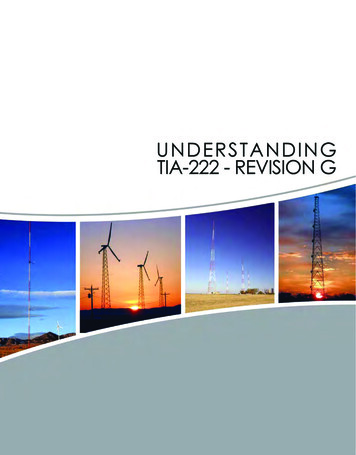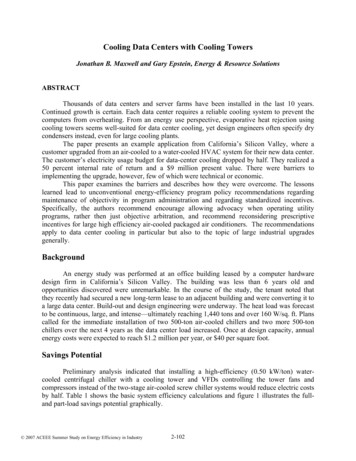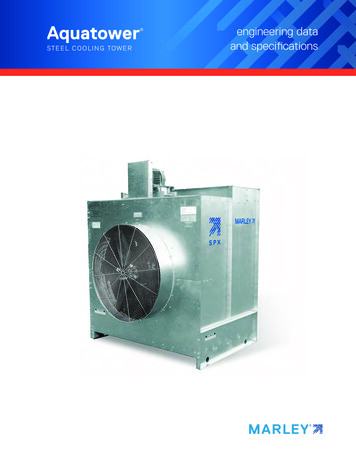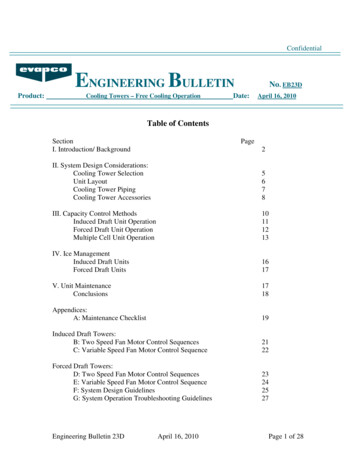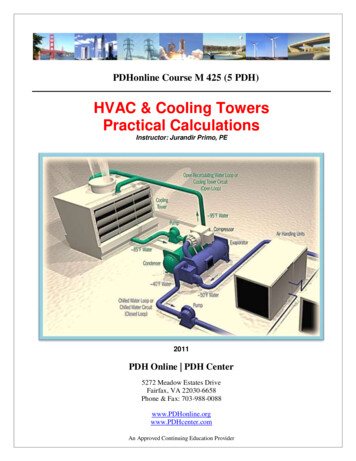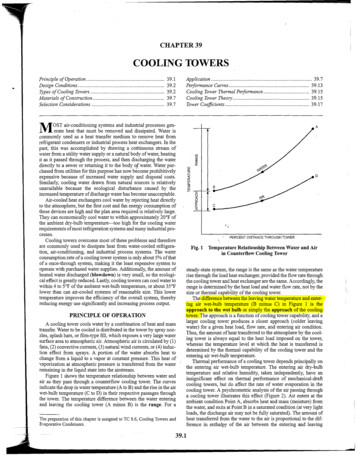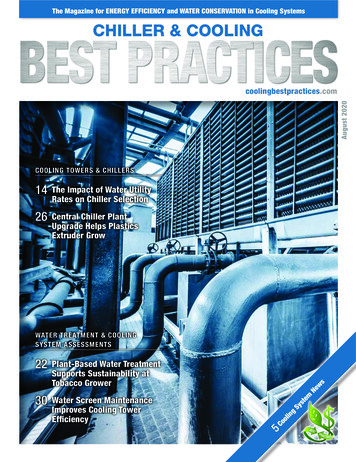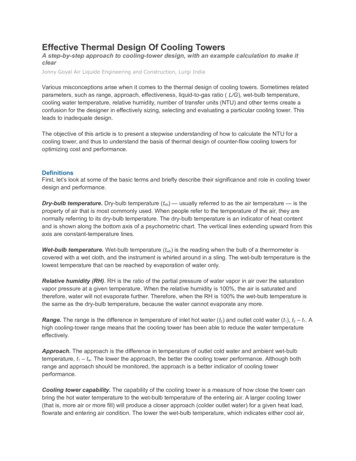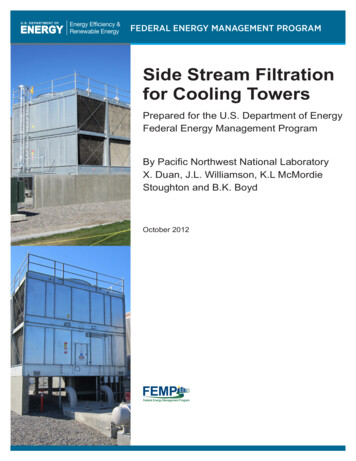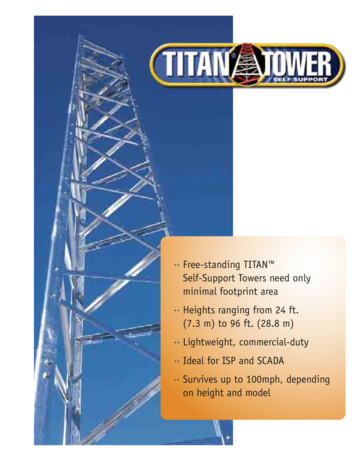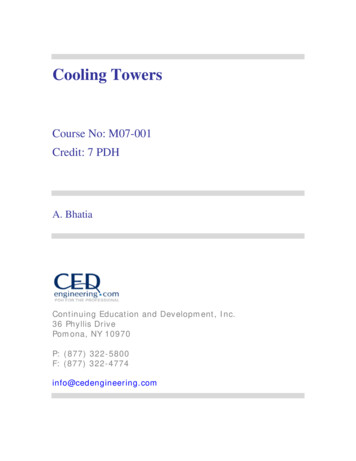
Transcription
Cooling TowersCourse No: M07-001Credit: 7 PDHA. BhatiaContinuing Education and Development, Inc.36 Phyllis DrivePomona, NY 10970P: (877) 322-5800F: (877) 322-4774info@cedengineering.com
Cooling TowersMost industrial production processes need cooling water to operate efficiently andsafely. Refineries, steel mills, petrochemical manufacturing plants, electric utilitiesand paper mills all rely heavily on equipment or processes that require efficienttemperature control. Cooling water systems control these temperatures bytransferring heat from hot process fluids into cooling water. As this happens, thecooling water itself gets hot; before it can be used again it must either be cooled orreplaced by a fresh supply of cool water.A Cooling Tower is a heat rejection device that extracts waste heat to theatmosphere by cooling a stream of hot water in the tower. This type of heat rejectionis termed "evaporative" because it allows a small portion of the water being cooledto evaporate into a moving air stream and thereby provides significant cooling to therest of that water stream. The heat that is transferred from the water stream to theair stream raises the air's temperature and its relative humidity to 100%, and this airis discharged to the atmosphere.Types of Cooling ProcessesTwo basic types of water cooling processes are commonly used. One transfers theheat from warmer water to cooler air mainly by an evaporation heat-transfer processand is known as the evaporative or wet cooling. These are also termed as opensystems. The other transfers the heat from warmer water to cooler air by a sensibleheat-transfer process and is known as the non-evaporative or dry cooling. These arealso termed as closed cooling water systems because the water does not come incontact with outside air.Dry cooling towers operate by heat transmission through a surface that divides theworking fluid from ambient air. These rely mainly on convection heat transfer toreject heat from the working fluid, rather than evaporation. The cooling takes placethrough air-cooled exchangers similar to radiators.The advantages of these systems include:1. Precise temperature control, which is critical in many process applications
2. The water loss is negligible as the water remains in a closed loop. This systemconsumes very little water for make up and thus water treatment costs will beless. This system is recommended where water is scarce.3. Ability to operate at very high temperatures (200ºF) and under sub-freezingconditions using ethylene glycol, alcohol or brines.Other variant of closed cooling system is the once through system. Here the coolingwater is drawn from estuary, lake or river; used in process once and is disposed backto the source. There is no re-circulation.Once-through cooling is usually employed when the cooling water demands are highand water is readily available in abundance. Environmental regulation of hot waterdischarge or concerns of aquatic life go against using this system. Local environmentauthority having jurisdiction must permit such installation.Evaporative systems is a recirculation water system that accomplishes cooling byproviding intimate mixing of water and air, which results in cooling primarily byevaporation. A small portion of the water being cooled is allowed to evaporate into amoving air stream to provide significant cooling to the rest of that water stream.Water is re-circulated and reused again and again. The water evaporation isapproximately 1% of the flow for each 10ºF drop in temperature. The heat from thewater stream transferred to the air stream raises the air's temperature and itsrelative humidity to 100%, and this air is discharged to the atmosphere.In general, the most applications rely on the use of evaporative cooling towersystems, which include wet cooling towers, cooling ponds or spray ponds.The course covers 18 sections of comprehensive information on evaporative coolingtowers and provides important aspects of cooling tower types, sizing, selection andperformance issues. Let’s first define few important terms for understanding thiscourse. A detailed glossary is provided at the end of the course.Cooling Tower Terms and DefinitionsSome useful terms, commonly used in the cooling tower industry:1. BTU (British thermal unit) - BTU is the heat energy required to raise thetemperature of one pound of water one degree Fahrenheit in the range from 32 F to 212 F.
2. Cooling Range - The difference in temperature betw een the hot water enteringthe tower and the cold water leaving the tower is the cooling range.3. Approach - The difference between the temperature of the cold water leavingthe tower and the wet- bulb temperature of the air is known as the approach.Establishment of the approach fixes the operating temperature of the tower andis a most important parameter in determining both tower size and cost.4. Drift - Water droplets that are carried out of the cooling tower with the exhaustair. Drift loss does not include water lost by evaporation. Proper tower design canminimize drift loss. The drift rate is typically reduced by employing baffle-likedevices, called drift eliminators, through which the air must travel after leavingthe fill and spray zones of the tower.5. Heat Load - The amount of heat to be removed from the circulating water withinthe tower. Heat load is equal to water circulation rate (gpm) times the coolingrange times 500 and is expressed in BTU/hr. Heat load is also an importantparameter in determining tower size and cost.6. Ton - An evaporative cooling ton is 15,000 BTU's per hour. The refrigeration tonis 12000 BTU’s per hour.7. Wet Bulb Temperature (WBT) - The lowest temperature that watertheoretically can reach by evaporation. Wet-Bulb temperature is an extremelyimportant parameter in tower selection and design and should be measured by apsychrometer.8. Dry-Bulb Temperature - The temperature of the entering or ambient airadjacent to the cooling tower as measured with a dry-bulb thermometer.9. Pumping Head - The pressure required to pump the water from the tower basin,through the entire system and return to the top of the tower10. Makeup - The amount of water required to replace normal losses caused bybleed off, drift, and evaporation.11. Bleed off - The portion of the circulating water flow that is removed in order tomaintain the amount of dissolved solids and other impurities at an acceptablelevel. As a result of evaporation, dissolved solids concentration will continuallyincrease unless reduced by bleed off
Section 1 – Evaporative Cooling TowersAn evaporative cooling tower is a heat exchanger that transfers heat from circulatingwater to the atmosphere. Warm water from the heat source is pumped to the top ofthe tower and will than flow down through plastic or wooden shells. As it fallsdownward across baffles, the water is broken into small droplets. Simultaneously, airis drawn in through the air inlet louvers at the base of the tower and travels upwardthrough the wet deck fill opposite the water flow. A small portion of the water isevaporated which removes the heat from the remaining water causing it to cooldown 10 to 20 C. The water falls down into a basin and will be brought back into theproduction process from there. Some of the water is lost to evaporation and thus thefresh water is constantly added to cooling tower basin to make up the difference.Cooling Tower PrincipleEvaporation results in cooling On a warm day when you work or play hard, your body heats up, and you begin tosweat. Because your skin is more moist than the air, the sweat EVAPORATES and itABSORBS heat from your body. By absorbing heat from your body, the temperatureof your body is lowered. It is the evaporation or the change from a liquid to a vaporof the water on your skin which causes the skin to be cooled. If you stand in abreeze, you feel cooler, even though the temperature of the breeze will be the sameas the temperature of still air. The breeze STEPS UP the EVAPORATION process ofthe sweat and more rapidly cools the body. It is not the breeze alone that makes youfeel cooler. It is the increase in the rate of evaporation which makes the body feelscooler.All cooling towers operate on the principle of removing heat from water byevaporating a small portion of the water that is recirculated through the unit. Theheat that is removed is called the latent heat of vaporization. Each one pound ofwater that is evaporated removes approximately 1,050BTU's in the form of latentheat. The amount of heat lost by the water depends on the temperature rise of theambient air before it leaves the tower. This means that both the dry bulb and wetbulb temperatures of the air are important. When WBT DBT, this conditioncorresponds to 100% relative humidity (RH) that implies the air is fully saturated.The air will no longer accept water and the lack of evaporation do not allow thewetted bulb to reject heat into the air by evaporation.
Higher the difference between DBT and WBT, lower is the relative humidity or drier isthe air. The lower relative humidity indicates greater capacity of air to absorb or holdwater and shall result in efficient lowering of water temperatures.Sensible Cooling The air temperature rises as it absorbs sensible heat from the water. This sensibleheat transfer occurs, if the dry bulb temperature (DBT) of air is less than the DBT ofwater. This may account for 20% of the cooling.Why Evaporative CoolingThe advantages of evaporative cooling stem from several key factors. First,evaporative cooling process use the ambient wet-bulb temperature of the enteringair as the heat sink, which is typically 10 F to 30 F lower than the dry bulb,depending on the local climate. The lower the temperature of the heat sink, the moreefficient will be the process.Second, the evaporative cooling process involves both latent and sensible heattransfer (primarily latent) where a small portion of the recirculating flow isevaporated to cool the remaining water. For every pound of water evaporated intothe airstream, approximately 1,050 Btu of heat is rejected. In contrast, a pound ofair at standard conditions has a heat content of only 0.24 Btu/1b- F, meaning thatmuch greater air volume is required to reject the same heat load in air cooled(sensible only) cooling systems as compared to evaporative cooled systems.Third, due to water's ability to efficiently transport large quantities of heat overrelatively long distances, water-cooled systems allow the economical separation ofthe process equipment and heat rejection equipment.Fourth, evaporative cooling towers allow direct contact between the water and theair, which is a highly efficient process. This mixing occurs in the fill, sometimes calledthe wet deck, which is typically comprised of sheets of thermoformed plastic. The fillprovides a large amount of low-cost surface area for air and water to contact eachother.These reasons combine to explain why evaporative cooling towers are smaller andrequire much less fan energy than air-cooled equipment.Summarizing:
Both the evaporative and sensible heat transfer occurs as the warmer water comesin contact with the cooler air.1. Total heat transferred Heat of evaporation Sensible Heat2. Every pound of water evaporated into the airstream allows the air to carry awayapproximately 1,050 Btu of energy from the process to be cooled. This valuevaries slightly with climate.3. Higher the difference between DBT and WBT, lower is the relative humidity (ordrier is the air) and more effective will be the cooling tower performance. Acooling tower should be installed in places where there is considerable differentialbetween dry bulb temperature and wet bulb temperature.Section 2 – Cooling Tower PerformanceCooling tower performance depends on four factors (1) Range; (2) Heat load; (3)Ambient wet-bulb temperature or relative humidity and (4) Approach.RangeRange is the temperature difference between the hot water inlet and cold wateroutlet at the tower. For instance a design demanding, the hot water coming @ 100ºFand required to be cooled to 90ºF is said to have a range of 10ºF.Increasing the range will reduce the capital cost and energy cost of the tower.Heat LoadHeat load of cooling water is indicated by standard heat transfer equation:Q m Cp TWhere Q is heat load in Btu/hr m is cooling water mass in lbs/hr Cp is specific heat of water 1 Btu/lb- F T is the inlet/outlet temperature differential in ºFThe above equation can be simplified in volumetric flow rates asQ (in Btu/hr) 8.33 lbs/Gallons x 60 hr/min x 1 x T (ºF)
Heat Load (Btu/hr) 500 x flow in GPM x Range in FWet-bulb Temperature (WBT)The Wet bulb temperature (WBT) is a site condition measured by placing a thin filmof water on the bulb of a thermometer. A non-wetted thermometer reading provides‘dry bulb’ temperature (DBT) reading. A comparison of wet and dry bulb readingsallows the relative humidity to be determined from a psychometric chart or the airproperties table. The wet bulb temperature is always lower than the dry bulb valueexcept when the air is fully saturated with water – a condition known as 100%relative humidity. This is when the wet and dry bulb temperatures are the same.A tower cannot cool the hot process water to a temperature any lower than the wetbulb temperature of the entering air.The wet bulb temperature is also the dew point of the ambient air. It is not possibleor practical to design a cooling tower that can provide cooling water equal to or lowerthan prevailing wet bulb temperature of the air. Each tower system must bespecifically sized for each geographic area’s prevailing summer wet bulbtemperature. High efficiency mechanical draft towers cool the water to within 5 or6 F of the wet-bulb temperature, while natural draft towers cool within 10 to 12 F.In general, it is assumed that the ambient air wet bulb temperature, usually obtainedfrom ASHRAE climatic design information (Table
towers and provides important aspects of cooling tower types, sizing, selection and performance issues. Let’s first define few important terms for understanding this course. A detailed glossary is provided at the end of the course. Cooling Tower Terms and Definitions Some useful terms, commonly used in the cooling tower industry: 1. BTU (British thermal unit) - BTU is the heat energy .
